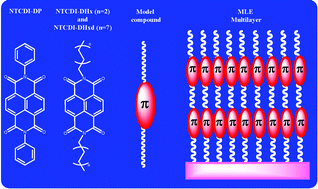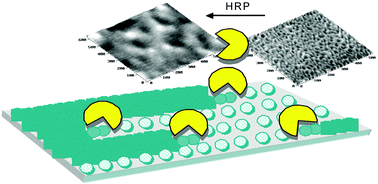Bardavid, Y. ; Kotlyar, A. B. ; Yitzchaik, S. Conducting Polymers Coated DNA.
MACROMOLECULAR SYMPOSIA 2006,
240, 102-106.
ArticleAbstractGold electrode was modified with a 4-aminothiophenol layer (4-ATPh) to immobilize DNA. The immobilized DNA served as a template for the alignment of positively charged anilinium ions. The electrochemical oxidation of the anilinium ions resulted in wrapping of the DNA with polyaniline. This polyaniline coated DNA was characterized by cyclic voltammetry (CV), impedance spectroscopy and UV-VIS absorption spectroscopy.
Ofir, Y. ; Zenou, N. ; Goykhman, I. ; Yitzchaik, S. Controlled Amine Functionality in Self-Assembled Monolayers via the Hidden Amine Route: Chemical and Electronic Tunability.
Journal of Physical Chemistry B 2006,
110, 8002-8009.
ArticleAbstractA synthetic strategy for fabricating a dense amine functionalized self-assembled monolayer (SAM) on hydroxylated surfaces is presented. The assembly steps are monitored by X-ray photoelectron spectroscopy, Fourier transform infrared- attenuated total reflection, atomic force microscopy, variable angle spectroscopic ellipsometry, UV−vis surface spectroscopy, contact angle wettability, and contact potential difference measurements. The method applies alkylbromide−trichlorosilane for the fabrication of the SAM followed by surface transformation of the bromine moiety to amine by a two-step procedure: SN2 reaction that introduces the hidden amine, phthalimide, followed by the removal of the protecting group and exposing the free amine. The use of phthalimide moiety in the process enabled monitoring the substitution reaction rate on the surface (by absorption spectroscopy) and showed first-order kinetics. The simplicity of the process, nonharsh reagents, and short reaction time allow the use of such SAMs in molecular nanoelectronics applications, where complete control of the used SAM is needed. The different molecular dipole of each step of the process, which is verified by DFT calculations, supports the use of these SAMs as means to tune the electronic properties of semiconductors and for better synergism between SAMs and standard microelectronics processes and devices.
Ofir, Y. ; Zelichenok, A. ; Yitzchaik, S. 1,4;5,8-Naphthalene-tetracarboxylicdiimide Derivatives as a Model Compounds for Molecular Layer Epitaxy.
Journal of Materials Chemistry 2006, 2142-2149.
ArticleAbstractThe physical properties and finite size effects observed in 1,4;5,8-naphthalene-tetracarboxylicdiimide (NTCDI)-based organic multilayers assembled by molecular layer epitaxy (MLE) are investigated by structure–property studies of low molecular weight model compounds. These molecules, aliphatic N,N′-dihexyl-NTCDI (1), N,N′-dihexadecyl-NTCDI (2) and aromatic N,N′-diphenyl-NTCDI (3), mimic the elemental building blocks of the solid-state heterostructures, NTCDI-based organic superlattices. Thermal analysis combined with polarized optical microscopy reveals that both 1 and 2 have polymorphic phases at an elevated temperature range. All model compounds show new absorption (abs.) and photoluminescence (PL) bathochromically shifted bands in concentrated (mM) solutions, as is also seen in MLE-derived organic superlattices. The strong tendency to aggregate and the photophysical properties of the model compounds are correlated with the PL and electrical field dependent electroluminescence (EL). This clarifies the structure-tunable emission by virtue of in-plane excitons in solid-state MLE structures. Finally, X-ray diffraction of single crystals of 1 and 3 reveal similar packing motifs for the molecules and the resulting solid-state MLE heterostructures.

Hai, A. ; Ben-Haim, D. ; Korbakov, N. ; Cohen, A. ; Shappir, J. ; Spira, M. E. ; Yitzchaik, S. Acetylcholinesterase-ISFET Based System for Detection of Acetylcholine and Acetylcholinesterase inhibitors.
Biosensors & Bioelectronics 2006,
22, 605-612.
ArticleAbstractA bioelectronic hybrid system for the detection of acetylcholine esterase (AChE) catalytic activity was assembled by way of immobilizing the enzyme to the gate surface of an ion-sensitive field-effect transistor (ISFET). Photometric methods used to characterize bonded enzyme and linker layers on silicon substrates confirm the existence of a stable amino-cyanurate containing AChE monolayer. The transduction of the enzyme-functionalized ISFET, in ionic solutions, is detected in response to application of acetylcholine (ACh). Recorded sensitivity of the modified ISFET to ACh has reached levels of up to 10−5 M. The Michaelis–Menten constant of the immobilized AChE is only moderately altered. Nevertheless, the maximum reaction velocity is reduced by over an order of magnitude. The ISFET response time to bath or ionophoretic application of ACh from a micropipette was in the range of a second. The catalytic activity of the immobilized AChE is inhibited in a reversible manner by eserine, a competitive inhibitor of AChE. We conclude that the immobilized enzyme maintains its pharmacological properties, and thus the described bioelectronic hybrid can serve as a detector for reagents that inhibit AChE activity.
Cohen, A. ; Shappir, J. ; Yitzchaik, S. ; Spira, M. E. Experimental and Theoretical Analysis of Neuron-Transistor Hybrid Electrical Coupling: The Relationships Between the Electro-Anatomy of Cultured Aplysia Neurons and the Recorded Field Potentials.
Biosensors & Bioelectronics 2006,
22, 656-663.
ArticleAbstractUnderstanding the mechanisms that generate field potentials (FPs) by neurons grown on semiconductor chips is essential for implementing neuro-electronic devices. Earlier studies emphasized that FPs are generated by current flow between differentially expressed ion channels on the membranes facing the chip surface, and those facing the culture medium in electrically compact cells. Less is known, however, about the mechanisms that generate FPs by action potentials (APs) that propagate along typical non-isopotential neurons.
Using Aplysia neurons cultured on floating gate-transistors, we found that the FPs generated by APs in cultured neurons are produced by current flow along neuronal compartments comprising the axon, cell body, and neurites, rather than by flow between the membrane facing the chip substrate and that facing the culture medium. We demonstrate that the FPs waveform generated by non-isopotential neurons largely depends on the morphology of the neuron.
Sfez, R. ; Peor, N. ; Cohen, S. ; Cohen, H. ; Yitzchaik, S. In Situ SFM study of 2D-Polyaniline Surface Confined Enzymatic Polymerization.
Journal of Materials Chemistry 2006,
16, 4044-4050.
ArticleAbstractIn this contribution we report on an in situ enzymatic self-assembly of a polyaniline (PAN) monolayer on modified hydroxyl-terminated surfaces. The consecutive assembly steps consist of a chemical deposition of 3-aminopropyltrimethoxysilane (APT) as a coupling agent with a positively-charged amine end group. The next step involved an electrostatic adhesion of sulfonated polystyrene (SPS) followed by electrostatic adhesion of anilinium. In situ enzymatic polymerization of the anilinium monolayer took place using horseradish peroxidase (HRP) enzyme and its substrate H2O2. The assembly steps were characterized by variable angle spectroscopic ellipsometry (VASE), UV-Vis-NIR spectroscopy, contact angle measurements, X-ray photoelectron spectroscopy (XPS), contact potential difference (CPD) and scanning force microscopy (SFM). The SFM measurements were divided between ex situ analysis in which morphology of the obtained layers was determined, and in situ analysis which provided information on the dynamic process of the enzymatic polymerization.

